The three men stood at the starting line in the pre-dawn indigo, with only the headlights of the chase Tesla backlighting them. They stood before the looming broadcast camera, surrounded by the Italian forest. An eerie silence. The scene was more reminiscent of a science fiction film than an athletics event.
They’d been selected by Nike, pared down from 60 of the best distance runners the company sponsored. Zersenay Tadese, Lilesa Desisa and Eliud Kipchoge were the last three standing, running a gauntlet of testing and evaluation for a project that was already in the works for years, and would take another two more to get them to where they were now standing.
These three marathoners were charged with what’s been compared to the athletic equivalent of the Apollo space missions, which put a man on the moon. But a better analogy for Breaking2, it’s christened codename, would be Project Mercury, NASA’s radical first attempt at putting a human being in space.
A F1 test driver sat behind the wheel of the lead Tesla, hired to drive a relentless and unflinching pace of a half-second faster than 21.1 km/hr six metres ahead of the runners – hopefully delivering one of them to a 1:59:59 marathon.
The three selected men stood out from their six pacers, who were uniformly clad in black. Tadese in pale blue, Desisa in white and Kipchoge, already one of the greatest marathoners of all time, in a cardinal red singlet. And all the focus was on him on the lonely road, with just these nine runners, the small group of sports scientists who shepherded the project, and the Nike support team gathered to start Breaking2 on the tarmac of the back curve of the 2.4-kilometre track of the Autodromo Nazionale Monza, the fastest F1 track in the world. A F1 test driver sat behind the wheel of the lead Tesla, hired to drive a relentless and unflinching pace of a half-second faster than 21.1 km/hr six metres ahead of the runners – hopefully delivering one of them to a 1:59:59 marathon. If none of the runners could keep up, he would carry on, haunting them, his brake lights fading around the next bend in the track.
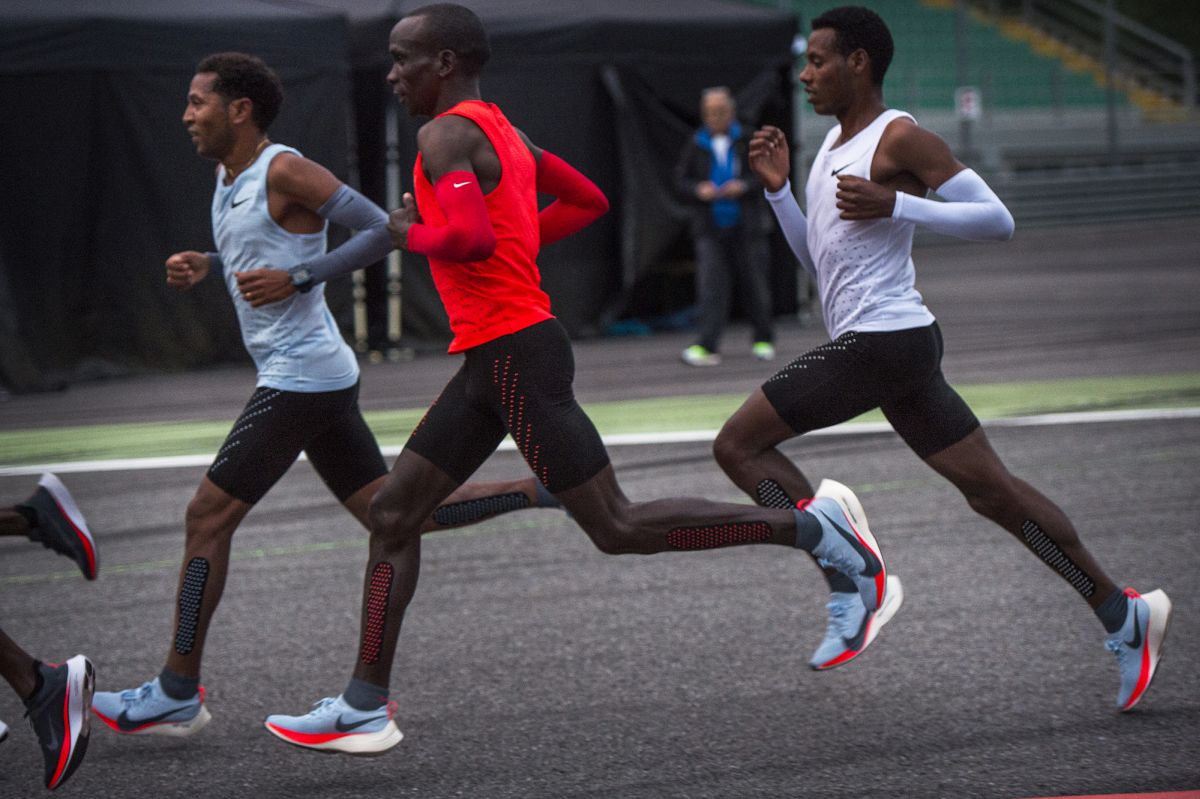
There was no great cheer from the 110,000-capacity grandstands when the trio set out to break two hours in the marathon. After all, there were only about 200 people in attendance in Monza, and we were all relegated to the finish line area. Nike had decided that Breaking2 would be a highly controlled experiment. The crowd consisted of about 100 international journalists (handpicked by Nike), 50 or so lucky members of Nike’s Run Club, who’d been glamping just offsite, and an overworked and under-slept crew of about 50 the company’s most trusted employees, brought in from around the world, to fully control every possible variable of this grand running experiment.
This is the Breaking2 broadcast and, really, the identity of the project itself – painfully self-aware, tense, personal and, as is used many times by the Nike team, audacious.
Sandy Bodecker, a VP with Nike, who was so invested in the project that he had “1:59:59” tattooed on his wrist, held the air horn, nervously swaying from side-to-side. The commentators, looming above him, mention this detail and the camera, also suspended overhead and always watching, catches Bodecker’s nervous smile as he is the spotlight for a moment. This is the Breaking2 broadcast and, really, the identity of the project itself – painfully self-aware, tense, personal and, as is used many times by the Nike team, audacious.
The pre-dawn sky, unclear and threatening to let loose rain at some point in the day, is interrupted by a laser fired onto the ground from the back of the Tesla which illuminates the spot where a 1:59:59 will be achieved. The phalanx of six pacers shake their legs out as the green line cuts across them.
The silent Tesla turns on. All we hear is birdsong overtop the pensive electronic soundtrack back at the finish line. It’s reminiscent of Trent Reznor and Atticus Ross’s work on David Fincher films. Livestream host Sal Masekela, a veteran of the decidedly more uptempo X Games broadcasts, echoes throughout the surrounding forest of Monza Park, which was once Napoleon’s stepson’s backyard when Italy was under French occupation at the turn of the 18th century.
https://www.youtube.com/watch?v=uvhSgxUdsdQ
Bodecker pulls the airhorn. The athletes lunge forward delicately, like the beginning of a 10,000m track race more than the scrum of a big city marathon. The six pacers quickly form a protective chevron, and the back three will be subbing in and out just before the end of each lap. This group of wind blockers and quiet cheerleaders will serve as the single most important component in getting Eliud Kipchoge so close to the unthinkable in 17 laps time.
Apart from the rhythmic din of their footfalls, the runners only hear the birds and the distant echo of Paula Radcliffe, also commentating. Then, the soon to be crucial beep of the first 200m timing mat. The numbers flash up on the board affixed atop of the Tesla: 35 seconds. On pace for 2:50/km–1:59:59 pace. These tiny splits will become constant and crucial feedback for Kipchoge as the enormity of the task becomes overwhelming. For now, he just focuses on his footfall – his custom made VaporFly Elites striking the tarmac just to the right of the red painted line. His perfect path to a sub-two-hour marathon.
“To focus too much on the shoes is a mistake.”
IT’S NOT ABOUT THE SHOES
“To focus too much on the shoes is a mistake,” says Dr. Philip Skiba of the Nike Sports Research Lab (NSRL) when asked about the role Nike’s custom shoe has played in this whole project. “The shoes don’t go without the human. The shoes don’t provide anything in particular. This is not magic. We’re really focused on the person. What can we do to get the most amount out of the human.”
“I think the first place we wanted to start was to explore human potential,” says Dr. Brett Kirby, the lead physiologist for the project, responding to a question about why the NSRL, who’ve spearheaded Breaking2 since 2014, decided to stage a closed event instead of an old-fashioned race. “We had to enable them and give the certain circumstances to allow them to unveil the possibility.”
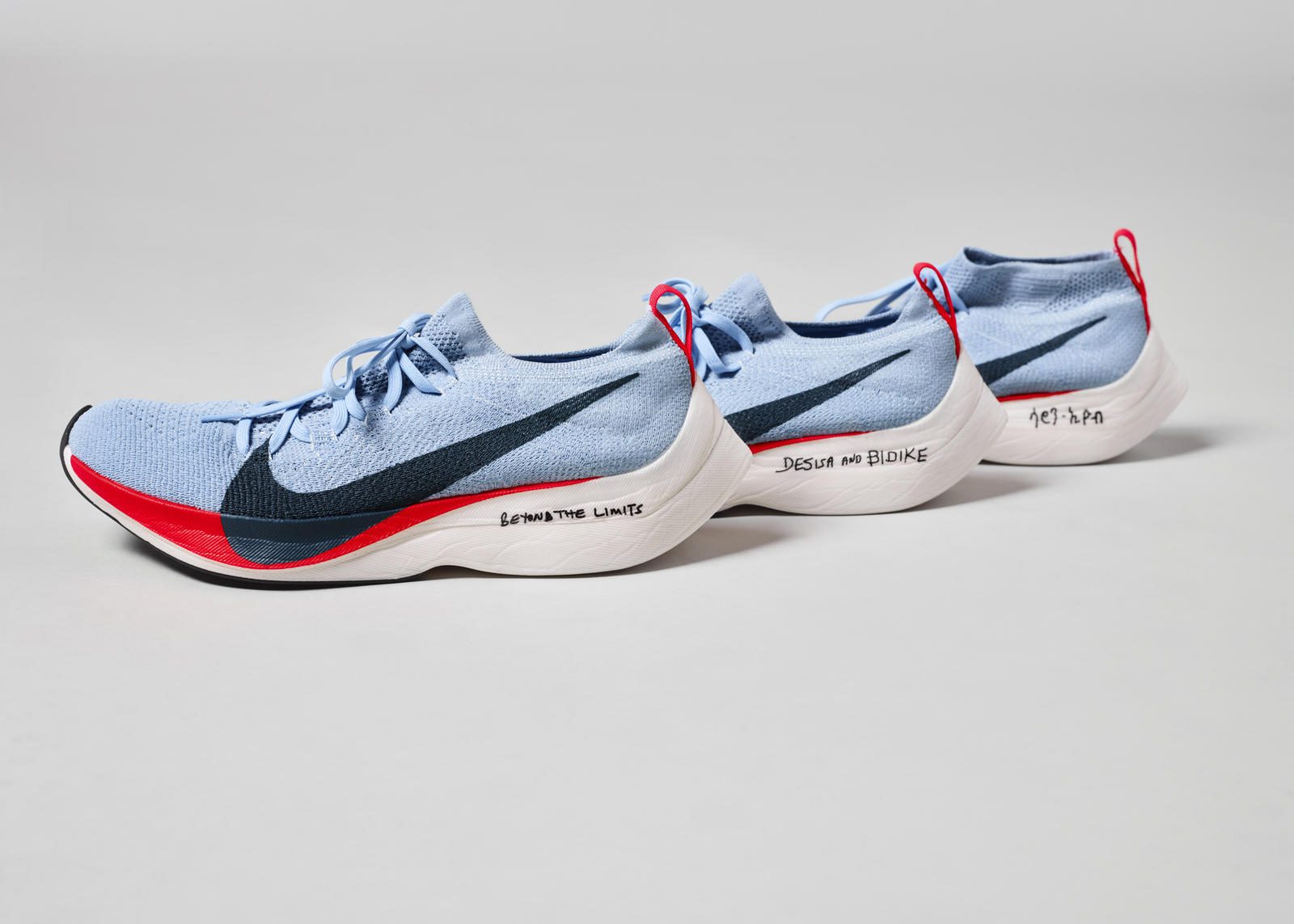
Breaking2 has been framed as a highly controlled event, leaving no variable to chance and obsessing over perfection in a sport where the elements often play the biggest role in the outcome. But the Beaverton, Ore.-based NSRL team have been surprisingly hands off about many key factors that determine the outcome of a marathon. For one, they only visited Tadese, Desisa and Lilesa in their respective training environments a few times, checking in and offering help in areas they determined in the lab to be weak spots in their training and preparation.
About 20 athletes train with Kipchoge at the Global Sports camp in Kaplangat, Kenya. They live like monks. Kipchoge, a wealthy and powerful man in Kenya, shares a room with a training partner, and sleeps in a single bed. A small poster hangs over it with a quote by the Brazilian writer Paulo Coelho, reminding Kipchoge, “If you want to be successful, you respect one rule: never lie to yourself.” Out back, the 20 athletes share a single outdoor latrine.
“I think the first place we wanted to start was to explore human potential.”
The dirt track where they do their hardest sessions is surrounded by trees and scattered shacks in the distance, with one makeshift metal grandstand, its Kelly green and white paint flecking with age. It could only fit maybe 15 people, but no one attends as the greatest marathoner in history trains for the most important run of his life.
THE OBVIOUS FIX: NUTRITION
“They’re going into this and saying, ‘This is unknown to me,’ and they have to explore the way they train and eat and raise the level,” says Kirby, in a media scrum at the track on the eve of the race. Kirby will follow the three runners for the entire race on a bicycle, offering up a totally different approach to nutrition and hydration than ever attempted previously in a marathon. NSRL is guarded about the details of the athletes’ fuelling strategies, but they say that they’ve calibrated each runner’s plan to meet their needs based on intense lab testing. Kirby and Skiba, do say that one major mistake a runner makes in a marathon is throwing the same type of carb at the body throughout the race, and only at 5k intervals in larger quantities.
Kipchoge ended up using a new Swedish product created by a startup called Maurten. It’s tasteless and was administered along the course in small, steady increments. The difference between Maurten and a traditional sports drink like Gatorade is that it’s made of algae and pectin, instead of sugar and an electrolyte solution. Perfectly balanced, this combination can be absorbed by the body three times more efficiently. The problem with traditional sugar-based drinks is that, as the carb concentration increases, the stomach actually slows down the absorption period. Keninisa Bekele used it in his winning run at the 2016 Berlin Marathon, running the second fastest marathon of all time. In an interview with Sports Illustrated, one of Maurten’s founders called it the Tesla of sports drinks – fitting for Breaking2, which is perhaps the Tesla of marathons.
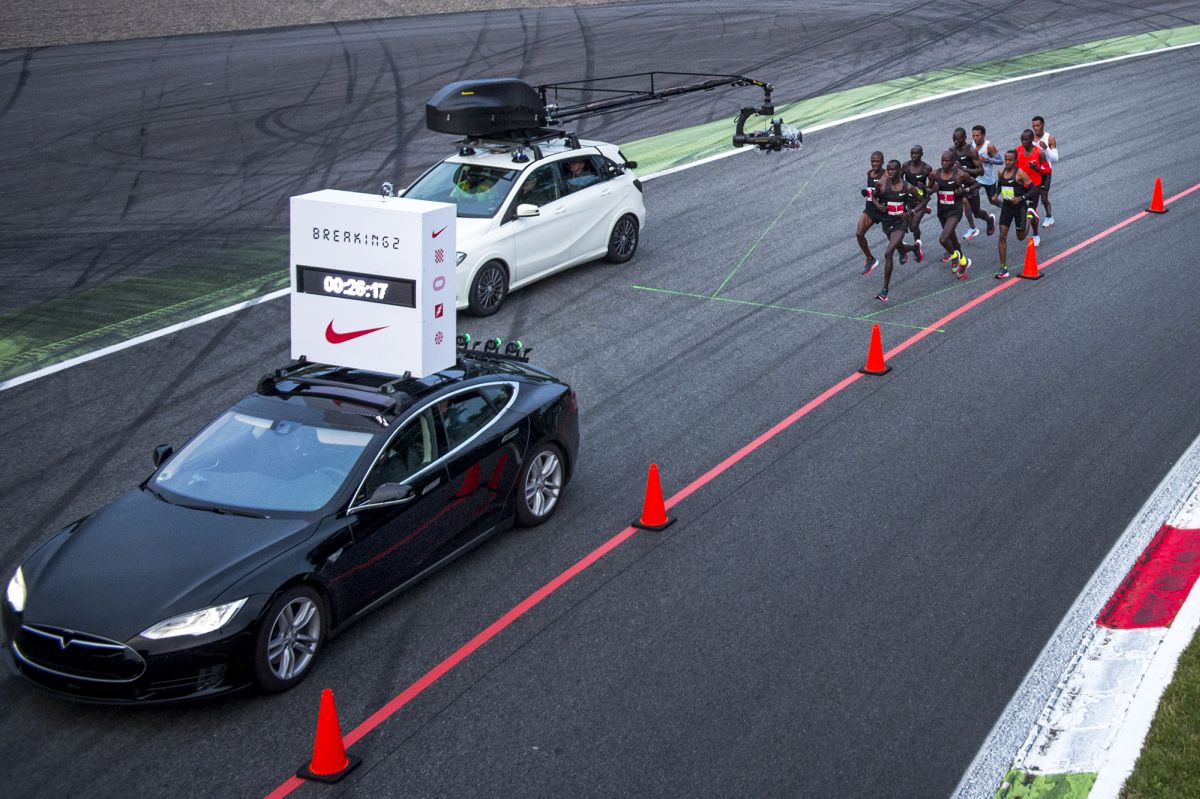
BUT WHAT ABOUT BERLIN?
“I don’t think any of the major city marathon courses are perfect,” says Dr. Andy Jones, who was brought in to consult as a member of the NSRL team from the University of Exeter. His work with Paula Radcliffe led to her world record marathon breakthrough, arguably a performance on par with a 1:59 marathon, which was done on a conventional course at the London Marathon. “They all have twists and turns and cobbles or hills, we wanted a completely optimal course and conditions with this.”
“When I came to Italy, Nike left my return flight open, telling me they might move the race a day. If Breaking2 were set to happen on the Saturday, it would have been a non-starter, something no major city race can afford to do.”
The four scientists, led by Dr. Brad Wilkins, the director of NSRL, scrutinized the concept of the marathon and fixated on the aspects that seemed to take away from an athlete’s optimal opportunity to perform at 100 per cent. They decided they needed to control for temperature, wind, humidity, and ideally have a cloudy day. “In a big city marathon, those are fixed because of the thousands of participants,” Jones points out on the balmy afternoon before Breaking2 was set to happen. When I came to Italy, Nike left my return flight open, telling me they might move the race a day. If Breaking2 were set to happen on the Saturday, it would have been a non-starter, something no major city race can afford to do.
Before settling on Monza, the team looked at just about every potentially optimal stretch for running a fast yet fair marathon. They inspected a dyke in the Netherlands with a favourable tailwind (which they apparently dismissed to avoid criticism about the wind). They sought out a large indoor course and considered the convention centre in Chicago, but they couldn’t harness the air conditioning. They also apparently looked at another F1 track, in Montreal, but the weather was not trustworthy enough. Picking the home of the Italian F1 Grand Prix, a palace of modern speed-centric technology, seemed like a brilliant marketing move. But Monza’s weather, elevation and gradual course are ideal for an outdoor attempt at a fast marathon.
But the weather continued to be a vexing problem. Sure, the starting temperature as the runners stood on the backside of the track was 10 C, which is nearly ideal for running a fast marathon, but the humidity remained high throughout the race, and even increased as it went on. Humidity can be tricky; if it’s not overly warm, it seems like a non-factor. The overcast sky kept the pulverizing sun from scorching the runners, but the blanket of moisture produced a slow smothering effect, like sitting in a closed garage with a Vespa idling in the corner. It seems ineffectual, almost cute at first. But, in time, its vapours have a vampiric effect on you.
THE CROWD GOES SILENT
Standing at the sideline, Breaking2 quickly became pensive yet hypnotic. The first jarring shift back to the reality of watching a group of runners float by at 2:50/km was when Desisa was quickly dropped at 51 minutes. Just as in any major city marathon, he seemed to shoot off the back, discarded to run his own race. Then Tadese began to slip, losing contact just after 59 minutes, as the rest of the arrowhead neared the halfway mark on pace.
At about 35k, Kipchoge begins to show signs of fatigue, with his pack of six pacers slipping back ever so slightly, first by only a few seconds, opting to stay with him instead of chasing the uncaring Tesla.
With three laps to go, Kipchoge begins to smile. He starts looking up more, at nothing in particular, but taking in what he’s in the midst of doing. He is suffering, yes, but that’s in a sense why he starts to smile: he’s choosing to do this, to hurt.
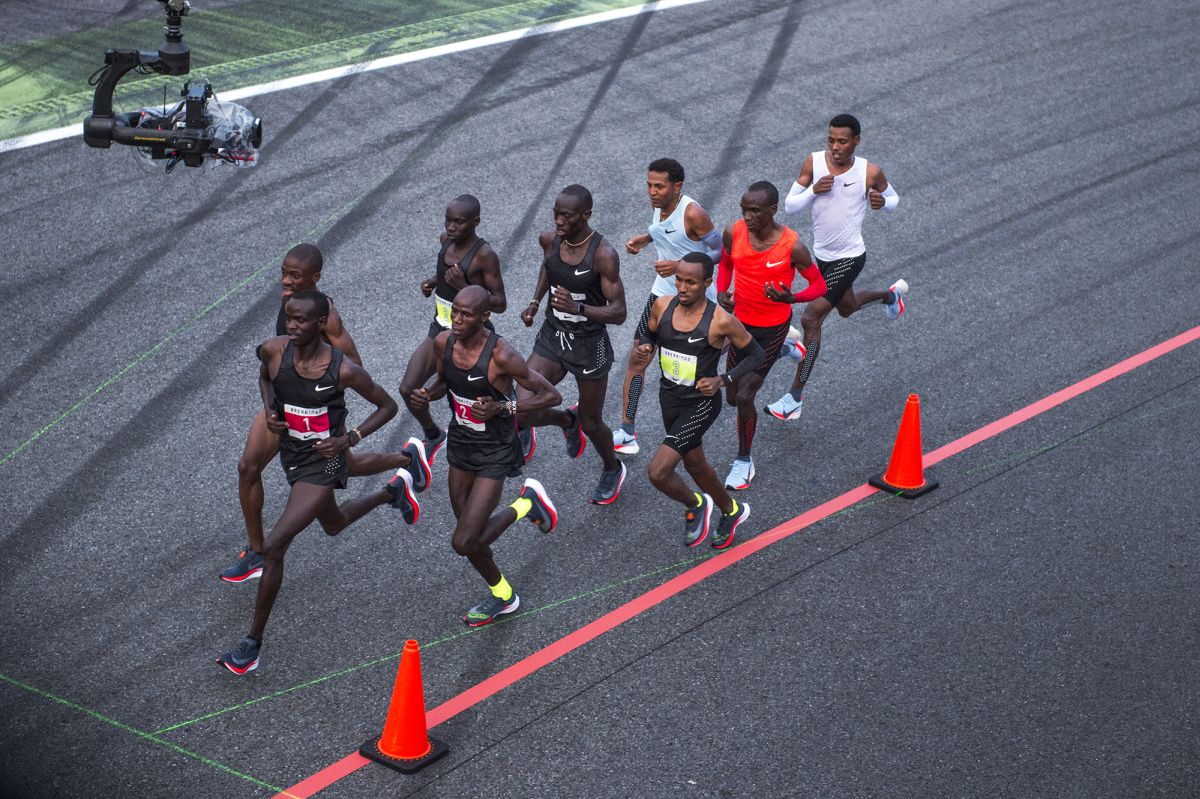
As they rounded the corner past the 38k marker, the Tesla already left the turn, too far out of reach. Kipchoge takes his fuel anyway, and carries on. It’s silent as they hit the back stretch, with only two nsrl scientists trailing Kipchoge on bikes, timing crew and kilometre marker attendants cheering them on. A dangerous three-metre gap then opened between Kipchoge and his pace group. As they go through the final pacer exchange zone, just before beginning the last lap, one fresh recruit pulls alongside Kipchoge, giving him positive encouragement. He’s 18 seconds off pace, with only 2.5 kilometres to go. The pace group clearly doesn’t know what to do as he begins to slip further back.
“Later, Kipchoge admitted in the press conference that he missed the thousands of people lined up along the streets of a big city marathon.”
The crowd, or lack thereof, became a factor at this late stage. Later, Kipchoge admitted in the press conference that he missed the thousands of people lined up along the streets of a big city marathon. When he began to slip off pace he needed a psychological boost that he could not summon within himself to lift him back into the protective pocket of pacers. Instead, Kipchoge battled the ominous grandstands on the back straightaway, hanging on until finally getting lured in by the tiny crowd waiting for him at the finish line one last time. The four remaining pacers fractured away from him as if he was about to crash into the Earth. They hopped in the air with excitement, yelling at him to push harder, the final pacer pulling off to the side with 200m to go, willing Kipchoge to somehow cover the distance in a single step. They then watched as the clock turned over from 1:59:59 to 2:00.
Kipchoge didn’t relent, running hard to the finish, wincing turning to a smile. Later, he told me that he chooses to smile when he feels pain. “You have to choose to be happy,” he said.
He crossed the line, broke the tape and continued to jog for a moment, before collapsing to the ground in a mix of exhaustion and elation. He may not have broken a sanctioned world record, but he ran the fastest marathon in history.
REINVENTING THE REINVENTED
Critics of Breaking2 feel that its highly controlled nature breaks from the tradition of marathoning. In fact, the modern marathon, where a large field of elite and recreational runners race through the roads of a major city, isn’t a very old concept and began as an ad hoc event. The first 42.195-kilometre course was created to appease royalty at the 1908 Olympics. Before that, the concept of a “marathon” just implied a very long, arduous footrace. Before the first London Olympics, something like Breaking2, with only three top distance runners slugging it out to run the fastest, the most laps or beat a certain time goal, was a more recognizable type of race than a pensive 42k run throughout a major city. After all, how would gamblers be able to bet on and then track the progress of their athlete if they took off from one point and then weren’t seen again until the end?
The Boston Marathon is the oldest continuous marathon in the world, and it only adopted the current marathon distance in 1927. The Berlin Marathon has become the proving ground for world record running over the last 14 years. The reason for this actually reveals Berlin as a sort of “Breaking2 light.” It’s the most favourable IAAF sanctioned course of all the major marathons. The weather in Berlin in late September is almost always a perfectly crisp 10 C. The organizers recognize how desirable the conditions are for attacking a world record and facilitate the opportunity with a group of pacers and usually target just a few of the fastest marathoners in the world to stage a very controlled race.
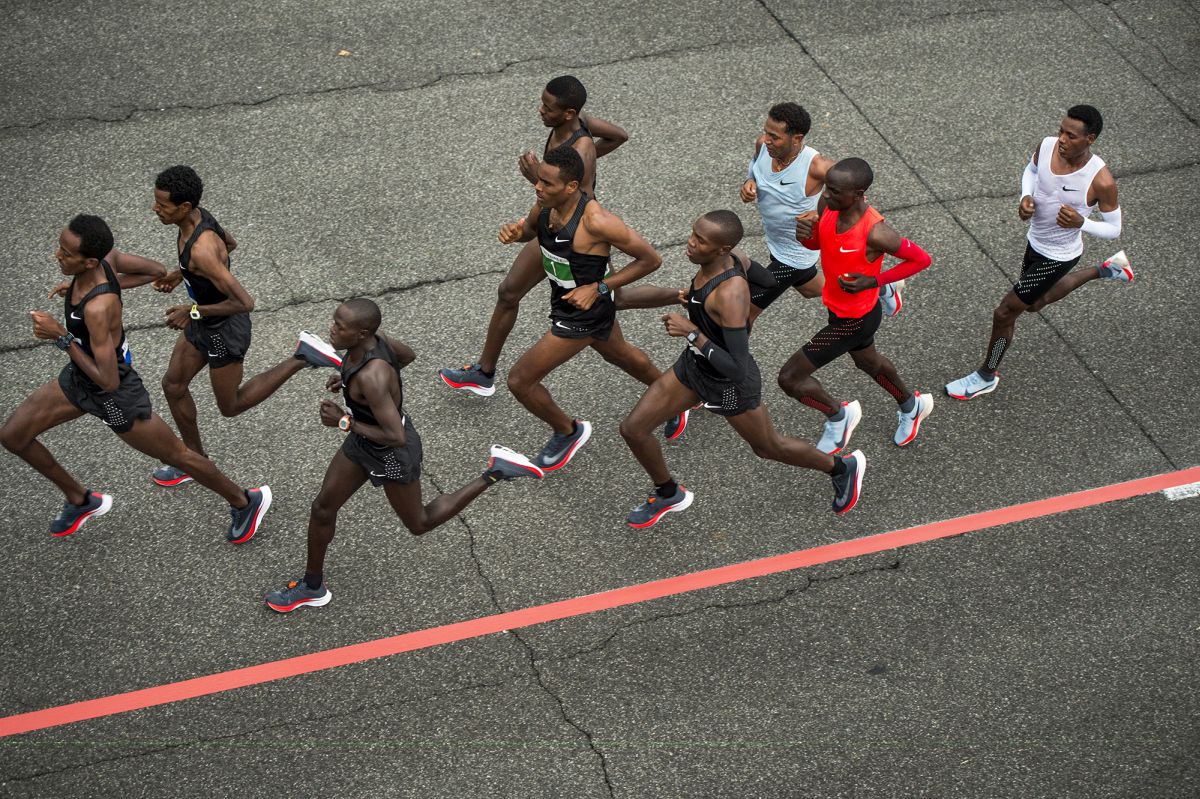
One major difference, however, with Berlin and Breaking2 is that there is still money on the line at a World Marathon Majors race. And although a world record would come with a huge payday, it’s far too risky for even the most talented marathoner to do something “audacious” as Nike would say. The pacers in Berlin are instructed to go out at just under world record pace, and then let the last men standing see if they can hold on or run a slight negative split in the second half. To continue the space program analogy, a world record attempt in Berlin is like the Apollo 13 mission: you hope to gain speed as you are slingshot back home as the pacers break away after 35K.
“No one has gone from the gun as hard as they can go,” Skiba points out. “They watch each other and they wait, and maybe at 15 miles they go. Now, we’re turning these guys loose from the gun. I think that’s one of the best things we’re doing for them – just saying, ‘Go for it.’”
“A small poster hangs over it with a quote by the Brazilian writer Paulo Coelho, reminding Kipchoge, “If you want to be successful, you respect one rule: never lie to yourself.”
Wilkins chimes in, emphatically: “We wanted to focus on the human. It can’t be understated. It’s the human, without outside factors that influence or impact the ability of a human to do it. We wanted to create the circumstances that allows them to achieve their potential. Nothing like heat or too many corners or hills. We wanted to take those things away and allow for the human to achieve their potential.”
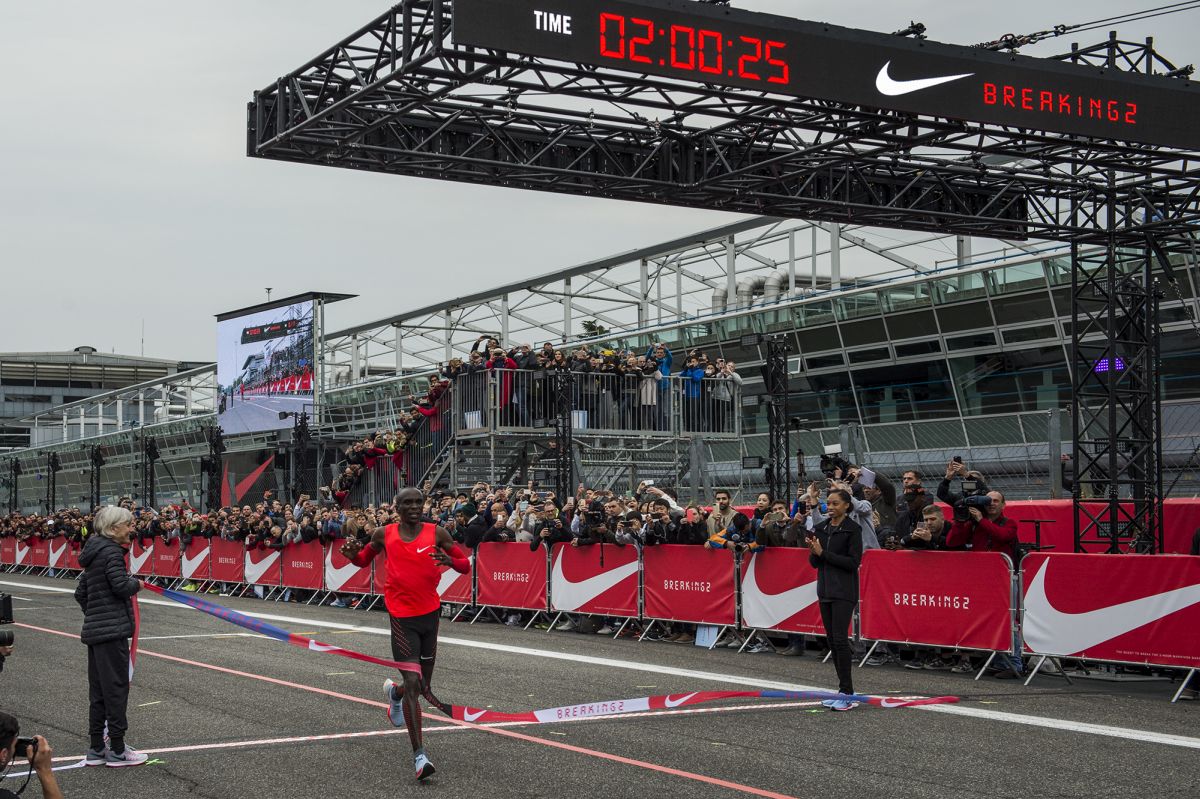
MAKING UP 26 SECONDS
Breaking2 was nearly the perfect Petri dish. The one minor criticism could be that the NSRL team decided not to be so controlling in the training and on race day. On race weekend, they forewent prodding and probing their three test subjects. Instead, they let them huddle with their coaches, and race. It was a remarkably pure moment of betting on the athlete instead of science. Kipchoge, Tadese and Desisa weren’t laden with diodes before the race to measure so many valuable takeaways. In order to make up those 26 seconds, they were not able to learn how quickly the three runners flushed lactate, how rapidly their core temperature warmed, which sorts of carbs they burned through first, the nature of their individual electric activity in their muscles, or which of them began to fail first. They didn’t measure exactly what their sweat rate was and how predictable (or not) it may have been, the specifics of their paces and, in particular, what exactly happened to Eliud Kipchoge in the last few laps of the course. Not knowing any of these variables ultimately cost him absolute god-like greatness and the unimaginable: the two-hour barrier, shattered.
They just let them run, which in retrospect means they left so much valuable information on the course. None of the athletes or pacers were heavily evaluated during the race, and it’s unclear if any significant data was collected from any of the athletes in the immediate aftermath of the race. Perhaps even more importantly, Tadese and Desisa’s races could provide exceptional data by contrast to Kipchoge’s nearly flawless run. None of that information seems to have been documented, which is a shame.
Early astronauts didn’t know if they’d make it back to Earth after being launched out of Earth’s atmosphere and into space. Like that mission into the unknown, Kipchoge, Tadese and Desisa just had to go for it and hope they’d make it. But after Kipchoge’s run in Monza, there’s also no turning back.
This feature appears in the July & August 2017 edition of Canadian Running.
